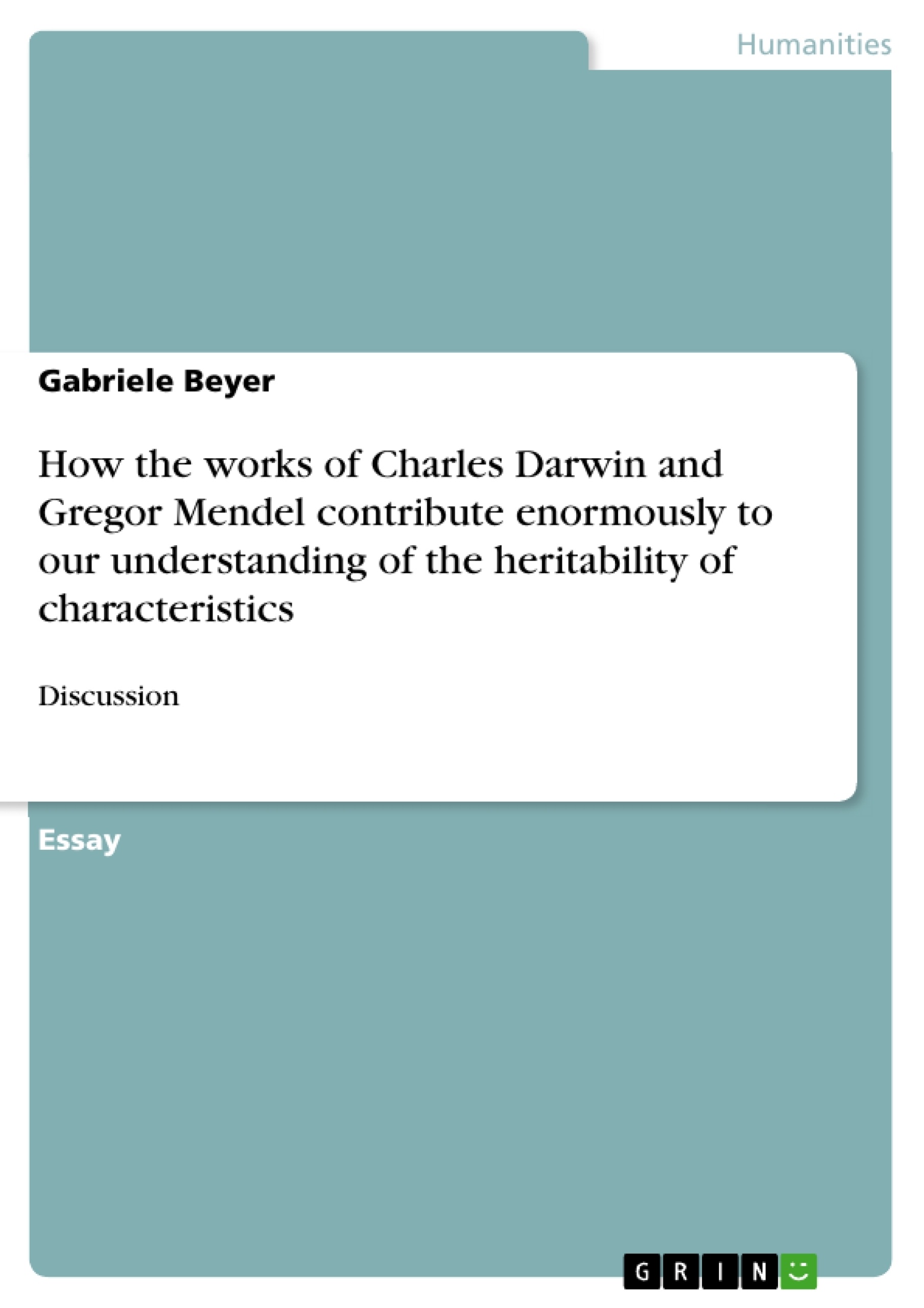Charles Darwin (1809 – 1882)1 was the first person who explained an evolutionary theorie and the transmutations of species by natural selection and fitness. He stated that character traits are passing from one generation to another. But he didn’t explain how this took place.
This is where Gregor Mendel (1822-1884)2 appears on the scene. He conducted research with pea plants and made genetical experiments. He was one of the major pioner handling with genetics. In the main Mendel figured out that two different types of genes do exist.
I will go more into deep under the chapters 2.2 and 3.2 ‘Theories’.
In the following these themes about genetics and how we –humans and every creature on this earthare receiving our characteristics, is what I want to single out during this essay.
Table of Contents
- Introduction
- Darwin and his work
- Short biography
- Theories
- Mendel and his work
- Short biography
- Theories
- Conclusion
- Summary
- Back to the research question
- Limits
Objectives and Key Themes
This essay aims to discuss the significant contributions of Charles Darwin and Gregor Mendel to our understanding of the heritability of characteristics. It explores Darwin's theory of evolution by natural selection and Mendel's groundbreaking work in genetics, highlighting their individual contributions and the interconnectedness of their discoveries.
- Darwin's theory of evolution by natural selection
- Mendel's laws of inheritance
- The concept of fitness and its role in natural selection
- The transmission of characteristics from one generation to the next
- The interplay between Darwin's and Mendel's theories in understanding heredity
Chapter Summaries
Introduction: This introductory chapter sets the stage for the essay by briefly introducing Charles Darwin and Gregor Mendel, highlighting their pioneering work in evolutionary theory and genetics respectively. It establishes the essay's central theme – exploring how their contributions significantly advanced our understanding of trait heritability, while acknowledging Darwin's inability to explain the mechanism of inheritance, a gap filled by Mendel's discoveries. The chapter emphasizes the intention to delve deeper into their theories in subsequent sections.
Darwin and his work: This chapter provides a concise biographical overview of Charles Darwin's life, marking key milestones and experiences, notably his voyage on the HMS Beagle and his observations on the Galapagos Islands, which profoundly impacted his evolutionary thinking. The section showcases the impact of his voyage and the gradual development of his understanding of species transmutation, laying the groundwork for his revolutionary theories. The emphasis on the Galapagos Islands and the variations observed amongst species underscores the crucial role of environmental influence in shaping his theory.
2.2 Theories: This chapter delves into the core tenets of Darwin's theory of evolution. It outlines Mayr's five hypotheses encapsulating Darwin's "On the Origin of Species," focusing on naturalism, transmutation, descent with modification, natural selection, and causal pluralism. The chapter clearly defines key terms – natural selection and fitness – explaining their significance within the theory. The discussion highlights the adaptive nature of traits and their impact on survival and reproduction, emphasizing the role of the Galapagos Islands as a pivotal site for Darwin's observations and conclusions. The complex interactions between these key components are elucidated to provide a more thorough understanding of Darwin's groundbreaking work.
Keywords
Charles Darwin, Gregor Mendel, evolution, natural selection, fitness, inheritance, genetics, heritability, transmutation, Galapagos Islands, adaptation, species, reproductive success.
Frequently Asked Questions: A Comprehensive Language Preview
What is the main topic of this text?
The text focuses on the significant contributions of Charles Darwin and Gregor Mendel to our understanding of heredity. It explores Darwin's theory of evolution by natural selection and Mendel's laws of inheritance, highlighting their individual contributions and the interconnectedness of their discoveries.
What does the Table of Contents include?
The Table of Contents covers an Introduction, sections on Darwin's and Mendel's work (including biographies and theories for each), and a Conclusion that summarizes the essay, revisits the research question, and discusses limitations.
What are the key objectives and themes?
The main objective is to discuss Darwin and Mendel's contributions to understanding heritability. Key themes include Darwin's theory of evolution by natural selection, Mendel's laws of inheritance, the concept of fitness, the transmission of characteristics across generations, and the interplay between Darwin's and Mendel's theories.
What are the chapter summaries?
The Introduction sets the stage, briefly introducing Darwin and Mendel and their contributions. The Darwin chapter provides a biography and explains his theory, emphasizing the Galapagos Islands' role. The Mendel chapter (not explicitly summarized in the provided text) would presumably detail Mendel's experiments and laws of inheritance. The Conclusion summarizes the findings, addresses the research question, and acknowledges limitations.
What are the key concepts explained in the Darwin section?
The Darwin section explains his theory of evolution by natural selection, focusing on Mayr's five hypotheses (naturalism, transmutation, descent with modification, natural selection, and causal pluralism). It defines key terms like natural selection and fitness, and highlights the importance of adaptation and reproductive success.
What keywords are associated with this text?
Keywords include: Charles Darwin, Gregor Mendel, evolution, natural selection, fitness, inheritance, genetics, heritability, transmutation, Galapagos Islands, adaptation, species, and reproductive success.
What is the overall purpose of this text?
This text serves as a comprehensive preview of a larger work, providing a structured overview of the content, objectives, and key themes for academic use and analysis.
Who is the intended audience for this text?
The intended audience appears to be academics or students interested in evolutionary biology and genetics, needing a concise overview of Darwin and Mendel's contributions.
- Quote paper
- MA Soziologie Gabriele Beyer (Author), 2011, How the works of Charles Darwin and Gregor Mendel contribute enormously to our understanding of the heritability of characteristics , Munich, GRIN Verlag, https://www.grin.com/document/211087




